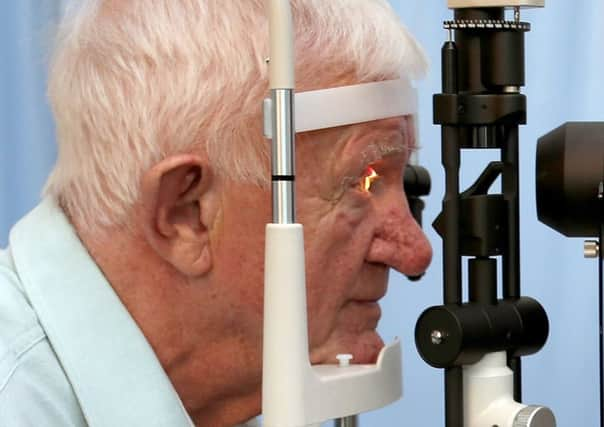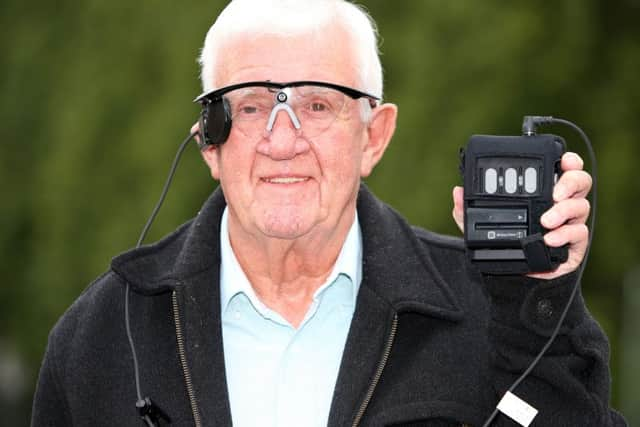Ground-breaking ‘bionic eye’ implant has opened Ray, 80, up to the world again


Ray Flynn, 80, from Audenshaw, Manchester, is the world’s first patient with advanced dry Age-related Macular Degeneration (AMD) to undergo the procedure.
The retired engineer, who still has peripheral vision, is also believed to be the first person to have the use of combined natural and artificial sight.
Advertisement
Hide AdAdvertisement
Hide AdMr Flynn has experienced deteriorating central vision for the last eight years but is now looking forward to a clearer view of his beloved Manchester United on television.
The keen cook’s quality of life had worsened due to his condition, needing to use a magnifying glass to read recipes, and trying to watch TV by sitting at an angle from the monitor.
AMD is the most common cause of sight loss in the developed world with between 20 and 25million sufferers worldwide. Mr Flynn is affected by dry AMD which does not affect his outer vision but is currently untreatable.
The Argus II retinal implant that he received last month at Manchester Royal Eye Hospital in a four-hour procedure had never been used to treat patients with AMD until Mr Flynn’s operation. The implant was switched live on July 1.
Advertisement
Hide AdAdvertisement
Hide AdHe said: “Before when I was looking at a plant in the garden it was like a honeycomb in the centre of my eye. That has now disappeared. I can now walk round the garden and see things.


“It’s definitely improved my vision but I haven’t been out and about on a bus yet. I don’t think I will for a little while.”
Developed by Second Sight Medical Products, the implant works by converting video images captured by a miniature camera housed in Mr Flynn’s glasses into a series of small electrical pulses that are transmitted wirelessly to electrodes on the surface of the retina. These pulses stimulate the retina’s remaining cells resulting in the corresponding perception of patterns of light in the brain.
The patient learns to interpret the visual patterns to regain some level of visual function.
Advertisement
Hide AdAdvertisement
Hide AdSince his operation, tests have revealed that Mr Flynn can make out the outline of people and objects even when his eyes are closed.
The unmarried pensioner was a regular at Old Trafford in his younger days and also regularly watched Manchester United play in Europe.
His brother, Pete, 77, said: “We don’t miss a game on the television but he can’t make out the players on the pitch and he can only watch if he sits in a certain position and looks from the corner of his eye.
“It gets very tiring for him, so watching the first game of the season should be a new experience.”
Advertisement
Hide AdAdvertisement
Hide AdThe Argus II implant has only ever been used before on 130 patients with rare eye disease Retinitis Pigmentosa (RP). They had no peripheral vision.
The results of the procedure have impressed both consultants and politicians.
Professor Paulo Stanga, consultant ophthalmologist and vitreoretinal surgeon at the Manchester Royal Eye Hospital, said: “Mr Flynn’s progress is truly remarkable. He is seeing the outline of people and objects very effectively.
“Ray had to do everything with his peripheral vision, it’s very tiring, it is exhausting, What we are hoping to achieve is to improve Ray’s central vision so he does not have to work so hard with his peripheral vision.
Advertisement
Hide AdAdvertisement
Hide Ad“This is new information that Ray’s brain is receiving and his brain now needs to get used to interpreting it.”
He said he looks forward to treating the remainder of the patients on the Argus II trial in Manchester. Four more patients are currently being recruited for the research project.
Minister for Life Sciences George Freeman added: “This ground-breaking research highlights the crucial role of the NHS as a test bed for 21st Century medicine.”
MOST COMMON CAUSE OF SIGHT LOSS IN THE DEVELOPED WORLD
Millions of people worldwide are suffering sight loss due to Age-related Macular Degeneration (AMD).
Advertisement
Hide AdAdvertisement
Hide AdThe condition is painless and generally leads to the gradual loss of central vision but can sometimes cause a rapid reduction in vision.
There are two main types of AMD, “wet” and “dry” based on the appearance of the eye. Dry AMD is by far the most common form of the disease and there is no treatment. However, sight-saving treatment exists for wet AMD if it is diagnosed in time. York-born actor Dame Judi Dench is a known sufferer of AMD, she has dry AMD in one eye and wet AMD in the other.